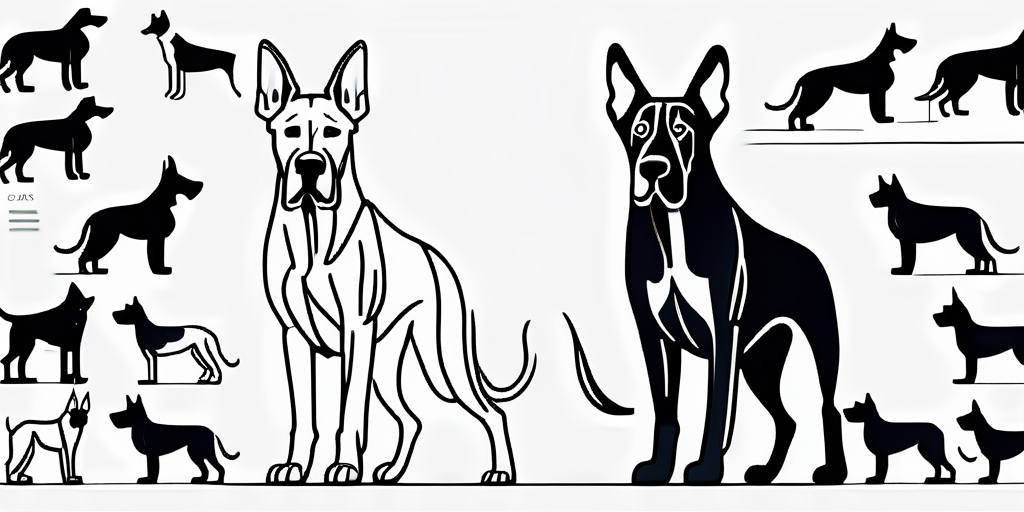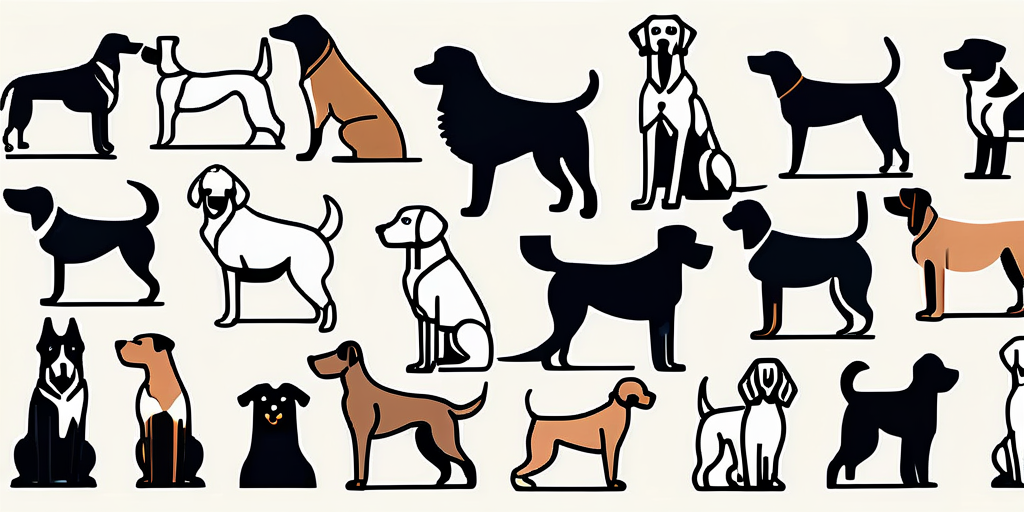When it comes to choosing a companion or a working dog, the Great Dane and the German Shepherd are two popular breeds that often come to mind. Both breeds have their unique characteristics and qualities that make them endearing to dog lovers. In this article, we will delve into the world of these two breeds and compare them in terms of their history, physical characteristics, temperament, training and exercise needs, as well as their health and lifespan.
Understanding the Breeds
The History of the Great Dane
The Great Dane, also known as the “Apollo of Dogs,” has a rich history that dates back several centuries. Originating from Germany, this gentle giant descended from the powerful Mastiff-like dogs used for hunting boars. Over time, the breed was refined and developed to become the magnificent and elegant dog we know today.

Great Danes are known for their impressive size and gentle demeanor, making them excellent family companions. Despite their imposing stature, they are often referred to as “gentle giants” due to their friendly and affectionate nature. These dogs require ample space to move around and thrive in environments where they can stretch their long legs and relax comfortably.
The History of the German Shepherd
The German Shepherd, on the other hand, is a relatively newer breed that was developed in the late 19th century by Captain Max von Stephanitz. Initially bred for herding purposes, the German Shepherd quickly gained recognition for its intelligence, versatility, and obedience. Today, these dogs are renowned for serving as police and military working dogs, as well as beloved family pets.
German Shepherds are highly intelligent and loyal dogs known for their courage and protective instincts. They excel in various roles, including search and rescue, therapy work, and as service animals. With proper training and socialization, German Shepherds can be wonderful companions for families, showing unwavering loyalty and devotion to their owners.
Physical Characteristics
Size and Weight Comparison
One of the most noticeable differences between the Great Dane and the German Shepherd is their size and weight. Great Danes are true giants, standing at an average height of 28-34 inches at the shoulder and weighing between 140-175 pounds. In contrast, German Shepherds are considered large dogs, but not as massive as Great Danes. They typically stand at 22-26 inches in height and weigh between 50-90 pounds.

Great Danes, often referred to as the “Apollo of Dogs,” have a commanding presence due to their sheer size and muscular build. Despite their imposing stature, they are known for their gentle and affectionate nature, often earning them the nickname “gentle giants.” On the other hand, German Shepherds are renowned for their versatility and intelligence. They are a popular choice for various roles, including police work, search and rescue, and as service dogs due to their keen intellect and loyalty.
Coat and Color Variations
Both breeds have distinct coat types and color variations. Great Danes have a short and smooth coat that comes in various colors, including fawn, brindle, blue, black, and harlequin. Their coat is easy to maintain with regular brushing to keep it shiny and healthy. In contrast, German Shepherds have a double coat consisting of a dense and straight outer coat with a softer undercoat. This double layer provides them with insulation against varying weather conditions, making them well-suited for outdoor activities.
When it comes to color variations, Great Danes exhibit a wide range of hues, from the elegant blue to the striking harlequin pattern. Each color variation adds to the unique charm of this majestic breed. German Shepherds, known for their iconic black and tan markings, also come in the striking sable coloration. The rich colors of their coat not only enhance their appearance but also serve a functional purpose, providing camouflage in their natural environments.
Temperament and Personality Traits
The Great Dane’s Personality
The Great Dane is often described as a gentle giant with a calm and friendly temperament. These dogs are known for their affectionate nature and strong bond with their families. They are generally good-natured and patient, making them suitable for families with children. However, their size and strength should be taken into consideration, especially when interacting with smaller children.
Despite their massive size, Great Danes are often referred to as “gentle giants” due to their sweet and loving disposition. They are known to be incredibly loyal and devoted to their families, often forming strong bonds with their human companions. Great Danes are also known for their playful nature, enjoying activities such as fetch and running around in open spaces. Their calm demeanor makes them great companions for those seeking a laid-back yet affectionate pet.
The German Shepherd’s Personality
German Shepherds are renowned for their intelligence, loyalty, and protective instinct. They are highly trainable and excel in various working roles, including search and rescue, police and military work, and even therapy dog duties. Despite their fierce appearance, German Shepherds can be affectionate and loving towards their families. However, early socialization and proper training are crucial to ensure they develop into well-rounded and well-behaved companions.
German Shepherds are not only intelligent and loyal but also incredibly versatile. Their keen sense of smell and high trainability make them ideal candidates for search and rescue missions, where their ability to track scents can save lives. Additionally, their protective nature and loyalty make them popular choices for police and military work, as they are willing to put themselves in harm’s way to protect their handlers. German Shepherds also excel in therapy dog roles, providing comfort and support to those in need with their gentle and empathetic demeanor.
Training and Exercise Needs
Training a Great Dane requires patience, consistency, and a gentle approach. These gentle giants respond well to positive reinforcement techniques, so be sure to have plenty of treats and praise on hand during training sessions. Starting training from an early age is crucial to ensure your Great Dane develops good behavior and socialization skills. It’s important to focus on basic obedience commands like sit, stay, come, and leash walking to establish a strong foundation for further training.
In addition to obedience training, mental stimulation is key for Great Danes. These intelligent dogs can easily get bored, so incorporating puzzle toys and interactive games into their routine can help keep their minds sharp and prevent destructive behaviors. Due to their large size and potential joint issues, it’s essential to avoid high-impact exercises and instead opt for low-impact activities like swimming and short walks to protect their joints and overall health.
Training a German Shepherd
- Begin training your German Shepherd as early as possible to capitalize on their intelligence and eagerness to learn.
- Use positive reinforcement methods, such as treats, praise, and play, to motivate and reward your dog.
- Focus on basic obedience commands, as well as more advanced training like scent detection or agility if desired.
- Provide mental and physical exercise daily to keep your German Shepherd stimulated and engaged.
- German Shepherds thrive on having a job to do, so consider providing them with tasks like carrying a backpack on walks or participating in obedience or agility competitions.
German Shepherds are known for their intelligence, loyalty, and versatility, making them excellent candidates for various types of training. Positive reinforcement techniques work well with this breed, as they are eager to please and respond positively to rewards like treats, praise, and play. Basic obedience commands are essential for German Shepherds, but their intelligence also makes them suitable for more advanced training such as scent detection or agility.
Providing daily mental and physical exercise is crucial for German Shepherds to prevent boredom and ensure they remain well-behaved. These dogs thrive on having a job to do, so giving them tasks like carrying a backpack on walks or participating in obedience or agility competitions can help channel their energy in a positive direction. By engaging both their minds and bodies, you can help your German Shepherd lead a fulfilling and well-balanced life.
Health and Lifespan
Common Health Issues in Great Danes
Like all breeds, Great Danes are susceptible to certain health issues. It is important to be aware of these potential health concerns to ensure the well-being of your Great Dane. Some common health concerns in Great Danes include:
- Gastric Dilatation-Volvulus (GDV), also known as bloat, which is a potentially life-threatening condition that requires immediate veterinary attention. Bloat occurs when the stomach fills with gas and twists, cutting off blood supply to the stomach and other organs. This can lead to severe pain, difficulty breathing, and even death if not treated promptly.
- Hip dysplasia, a genetic condition that affects the hip joints and can lead to pain and mobility issues. Great Danes, being a large breed, are particularly prone to hip dysplasia. This condition occurs when the hip joint does not develop properly, causing the bones to rub against each other, leading to inflammation and discomfort.
- Dilated cardiomyopathy, a heart condition that can cause heart failure in some Great Danes. This condition occurs when the heart muscle becomes weakened and enlarged, making it difficult for the heart to pump blood effectively. Symptoms of dilated cardiomyopathy may include coughing, difficulty breathing, and lethargy.
Common Health Issues in German Shepherds
German Shepherds, like many large breeds, are also prone to certain health conditions. It is crucial to be aware of these potential health issues to ensure the well-being of your German Shepherd. Some common health issues in German Shepherds include:
- Hip and elbow dysplasia, which can cause pain and mobility problems. This condition occurs when the hip or elbow joint does not develop properly, leading to abnormal wear and tear on the joint surfaces. It can result in arthritis, lameness, and difficulty moving.
- Degenerative myelopathy, a neurological disorder that affects the spinal cord and can lead to paralysis. This condition is progressive and typically affects the hind limbs first. It can cause weakness, loss of coordination, and eventually, complete paralysis.
- Exocrine Pancreatic Insufficiency (EPI), a condition where the pancreas fails to produce enough digestive enzymes. This can lead to poor digestion and absorption of nutrients, resulting in weight loss, diarrhea, and malnutrition. EPI is often managed with enzyme replacement therapy and a specialized diet.
It is important to note that while these health issues are more commonly seen in Great Danes and German Shepherds, not all dogs of these breeds will develop them. Responsible breeding practices, regular veterinary care, and a healthy lifestyle can help minimize the risk of these conditions. If you are considering getting a Great Dane or a German Shepherd, it is essential to research reputable breeders who prioritize the health and well-being of their dogs.
In conclusion, being aware of the potential health issues in Great Danes and German Shepherds is crucial for their overall well-being. Regular veterinary check-ups, a balanced diet, and appropriate exercise can go a long way in maintaining their health. By understanding and addressing these potential health concerns, you can provide the best possible care for your beloved canine companion.
Join the BreedRead Community
Deciding between a Great Dane and a German Shepherd is just the beginning of your journey with your new furry companion. At BreedRead.com, we provide you with all the necessary insights to make an informed decision and ensure a happy, healthy life for your dog. Subscribe to our free newsletter and gain access to a wealth of information, from detailed breed comparisons to tailored care guides. Let BreedRead be your trusted guide in the wonderful world of dogs.

